Carrier 48nex042301be, 01/pa4h, 01/pa4, 01/pa6, 01/pa6h Owner's Manual
...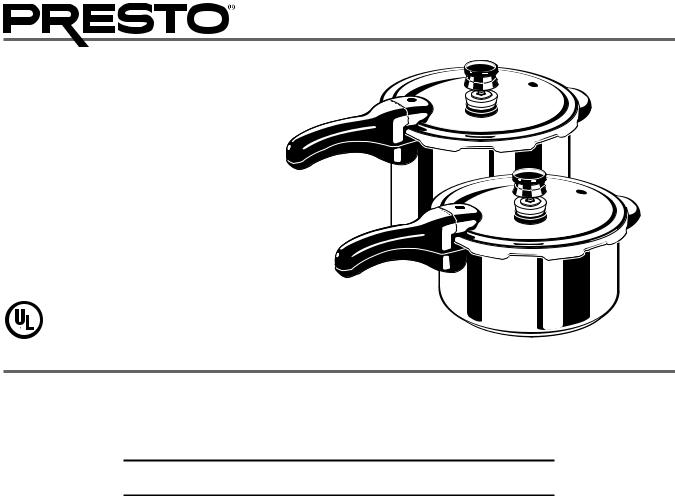
4- and 6-Quart
Aluminum
Pressure
Cookers
2006 by National Presto Industries, Inc.
Visit us on the web at www.GoPresto.com
Instructions and Recipes
Table of Contents
Important Safeguards |
. . |
. . |
. . |
. . |
. . |
. . |
. . |
. . |
. . |
. . |
. . |
. . |
. 2. . . . . . . . . . . |
Introduction . . . . . . |
. . |
. . |
. . |
. . |
. . |
. . |
. . |
. . |
. . |
. . |
. . |
. |
. 2. . . . . . . . . . . . . . |
Getting Acquainted . . |
. . |
. . |
. . |
. . |
. . |
. . |
. . |
. . |
. . |
. . |
. . |
. . |
. 3. . . . . . . . . . . . |
How to Use . . . . . . |
. . |
. . |
. . |
. . |
. . |
. . |
. . |
. . |
. . |
. . |
. . |
. . |
. 4. . . . . . . . . . . . . . |
Important Safety Information . . . . . . . . . . . . . . . . . . . . . 5. . . . . . . . .
Care and Maintenance . . . . . . . . . . . . . . . . . . . . . . . . . 6. . . . . . . . . . .
Helpful Hints . . . . . . . . . . |
. . |
. . |
. . |
. . |
. . |
. . |
. . |
. . |
. . |
. . |
8. . . . . . . . . . . . . . |
|
Questions and Answers . . . . |
. . |
. . |
. . |
. . |
. . |
. . |
. . |
. . |
. . |
. . |
9. . . . . . . . . . . |
|
Soups and Stocks . . . . . . . . |
. . |
. . |
. . |
. . |
. . |
. . |
. . |
. . |
. . |
|
. |
10. . . . . . . . . . . . . |
Seafood . . . . . . . . . . . . . . |
. . |
. . |
. . |
. . |
. . |
. . |
. . |
. . |
. . |
|
. |
13. . . . . . . . . . . . . . . . |
Poultry . . . . . . . . . . . . . |
. . |
. . |
. . |
. . |
. . |
. . |
. . |
. . |
. . |
|
. |
16. . . . . . . . . . . . . . . . |
Meats . . . . . . . . . . . . . . |
. . |
. . |
. . |
. . |
. . |
. . |
. . |
. . |
. . |
. |
.20. . . . . . . . . . . . . . . . |
|
Vegetables . . . . . . . . . . . . |
. . |
. . |
. . |
. . |
. . |
. . |
. . |
. . |
. . |
|
. |
25. . . . . . . . . . . . . . . |
Dry Beans and Peas . . . . . . |
. . |
. . |
. . |
. . |
. . |
. . |
. . |
. . |
. . |
. |
.29. . . . . . . . . . . . |
|
Grains . . . . . . . . . . . . . . |
. . |
. . |
. . |
. . |
. . |
. . |
. . |
. . |
. . |
|
. |
31. . . . . . . . . . . . . . . . |
Desserts . . . . . . . . . . . . . |
. . |
. . |
. . |
. . |
. . |
. . |
. . |
. . |
. . |
|
. |
33. . . . . . . . . . . . . . . . |
Recipe Index . . . . . . . . . . |
. . |
. . |
. . |
. . |
. . |
. . |
. . |
. . |
. . |
. |
.36. . . . . . . . . . . . . . |
|
Service and Parts Information |
. . |
. . |
. . |
. . |
. . |
. . |
. . |
. . |
. . |
. |
.37. . . . . . . . . |
|
Warranty . . . . . . . . . . . . |
. . |
. . |
. . |
. . |
. . |
. . |
. . |
. . |
. . |
|
. |
37. . . . . . . . . . . . . . . |

This is a  Listed appliance. The following Important Safeguards are recommended by most portable appliance
Listed appliance. The following Important Safeguards are recommended by most portable appliance
manufacturers.
IMPORTANT SAFEGUARDS
To reduce the risk of personal injury or property damage, basic safety precautions should always be followed, including the following:
1.Read all instructions..
2.Always check the vent pipe before use. Hold cover up to light and look through vent pipe to be certain it is clear.
3.Always check the air vent/cover lock to be sure it moves freely before use.
4.Do not fill pressure cooker over 2⁄3 full. For soup, grains, and dry beans and peas which expand during cooking, do not fill cooker over 1⁄2 full. Overfilling may cause a risk of clogging the vent pipe and developing excess pressure. See food preparation instructions.
5.Do not pressure cook applesauce, cranberries, rhubarb, cereals, pastas, dried soup mixes, or any dry beans and peas which are not listed on the chart on page 29. These foods tend to foam, froth, and sputter and may block the vent pipe, overpressure plug, and air vent/cover lock.
6.This appliance cooks under pressure. Improper use may result in scalding injury. Make certain pressure cooker is properly closed before operating; cover handle must be directly above the body handle. See “How To Use Instructions.”
7.Do not place the pressure cooker or attempt to pressure cook in a heated oven.
8.Extreme caution must be used when moving a pressure cooker containing hot liquids. Do not touch hot surfaces. Use handles or knobs.
9.Do not open pressure cooker until internal pressure has been completely reduced, air vent/cover lock has dropped, and no
steam escapes when the pressure regulator is removed. See “How To Use Instructions.”
10. Caution: To ensure safe operation and satisfactory performance, replace the overpressure plug every time you replace the sealing ring or sooner if it becomes hard, deformed, cracked, worn, or pitted. It is recommended that the sealing ring and overpressure plug be replaced at least every two years.
11. Close supervision is necessary when the pressure cooker is used near children. It is not recommended that children use the pressure cooker.
12. When normal operating pressure is reached, the pressure regulator will begin to rock. Gradually lower the heat to maintain a slow, steady rocking motion. If the pressure regulator is allowed to rock vigorously excess steam will escape, liquid will be evaporated, and food may scorch.
13. Caution: Do not use pressure cooker on an outdoor LP gas burner or gas range over 12,000 BTU’s. 14. Do not use this pressure cooker for other than intended use.
15. Do not use this pressure cooker for pressure frying with oil.
SAVE THESE INSTRUCTIONS
THIS PRODUCT IS FOR HOUSEHOLD USE ONLY.
Introduction
Welcome to the world of pressure cooking. With your new Presto Pressure Cooker, you’ll discover how fast and easy it is to prepare a wide variety of delicious foods—especially foods that emphasize good health and nutrition along with good taste.
The pressure cooker is perfect for the way we live and eat today. It’s ideal for preparing many of the lighter foods that help keep us healthy and fit. It preserves flavors and nutrients, tenderizes leaner cuts of meat and, best of all, it cooks foods three to ten times faster than ordinary cooking methods. And, it’s even possible to cook several foods in the pressure cooker at the same time without the flavors intermingling.
We have included recipes for some traditional family favorites that are especially well suited to the many advantages of pressure cooking. For your convenience, we have also provided nutritional information for all of the recipes in this book.
To help get started with your new pressure cooker, be sure to read the “Getting Acquainted” section beginning on the next page.
2
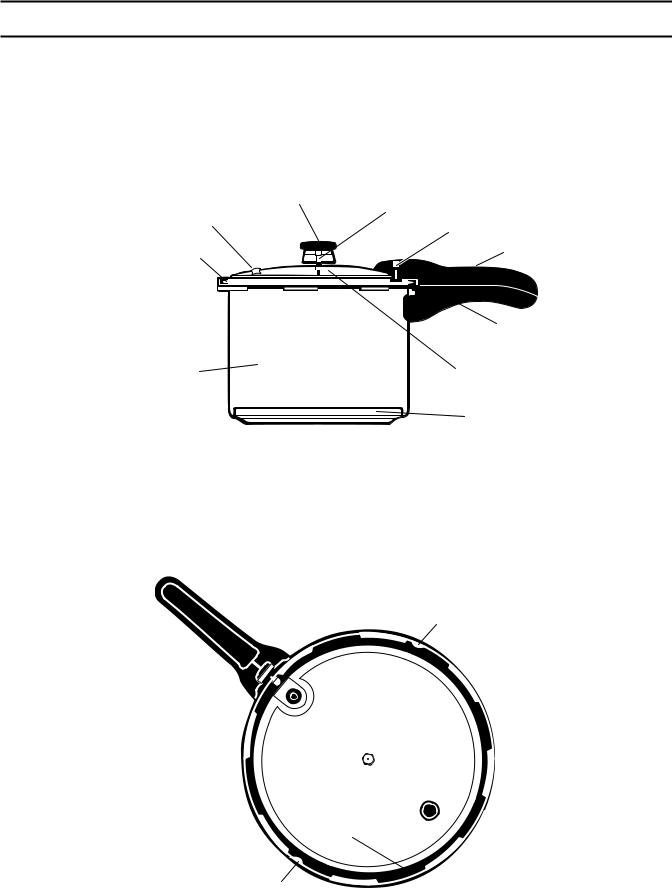
Getting Acquainted
Your pressure cooker is like a saucepan with a very special cover that locks in place. Air is automatically exhausted and steam is sealed inside creating pressure within the unit. Under pressure, internal temperatures in the cooker are raised above the normal boiling point of water, causing foods to cook faster. At 15 pounds of pressure, a temperature of 250° F. (or 121° C.) is reached inside the pressure cooker. These higher temperatures speed cooking and the moist steam atmosphere tenderizes meats naturally.
It is important to become familiar with the various parts of the pressure cooker (Fig. A) and to read the “How To Use” section beginning on page 4 before using the unit for the first time.
Pressure Regulator |
Vent Pipe |
|
|
Overpressure Plug |
Air Vent /Cover Lock |
|
|
Sealing |
Cover Handle |
|
|
Ring |
|
|
Body Handle |
Body |
Cover |
|
|
|
Cooking rack |
Fig.. A
Before the first use, remove the sealing ring (Fig. B) by simply pulling it out of the inside rim of the cover.
Wash sealing ring, cover, body, and cooking rack (Fig. A) in hot, sudsy water to remove any packaging material and white manufacturing lubricant. Rinse all parts with warm water and dry. Then, replace the sealing ring, being careful to fit it under the stop tabs and the lock pin (Fig. B) which are located on the inside rim of the cover.
Stop Tab
Lock pin 
Sealing Ring
Fig.. B
Stop Tab
3
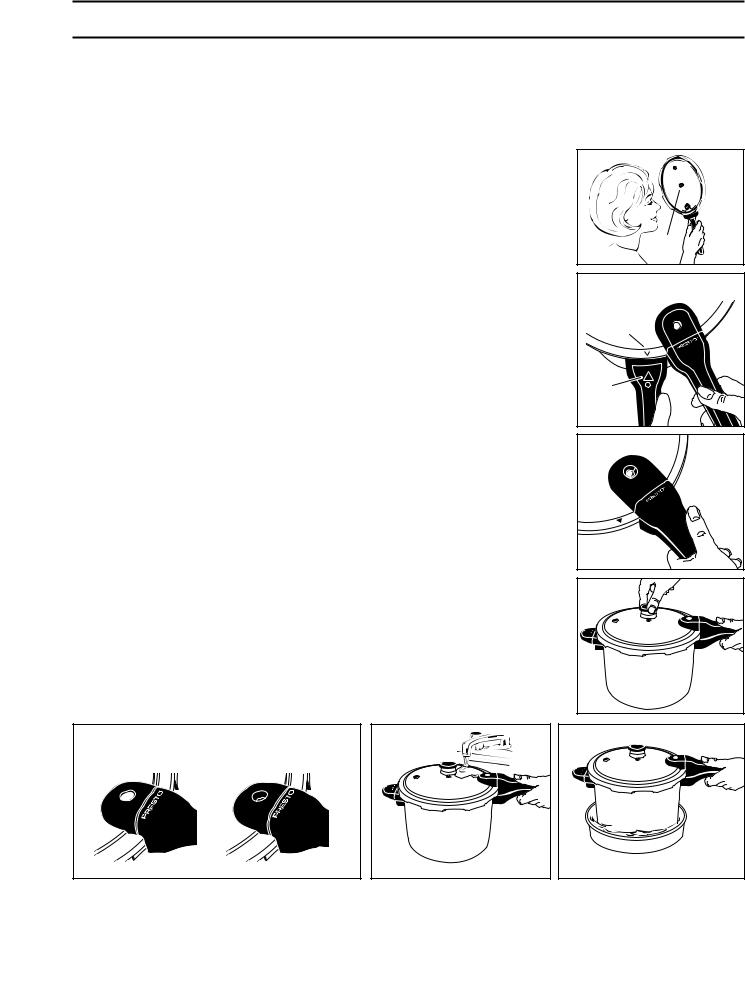
How to Use
To assure the very best results every time, carefully follow these step-by-step instructions for pressure cooking. You may find it helpful to refer back to Fig. A on page 3.
1. Prepare ingredients according to the directions in the pressure cooking recipe you have selected. Recipes in this book were developed for use in a 4-quart pressure cooker. If you have a 6-quart pressure cooker, you may increase the ingredients by 1⁄2, if desired. Be sure not to overfill the pressure cooker (see page 5).
Pour liquid into the cooker body, as specified in the recipe or timetable. This liquid is usually water. However, some recipes will call for other liquids, such as wine.
2.Place the cooking rack into the cooker, if called for in the recipe (see Helpful Hints on page 8 for guidance on when to use).
3.IMPORTANT: Look through the vent pipe to make certain that it is clear before closing the cover (Fig. C). See safety information on page 5.
Holding the body handle with your left hand and the cover handle with your right hand, align the V mark on the cover with the mark on the body handle and place the cover on the cooker body (Fig. D). Move the cover handle slightly until the cover drops into position.
4.Close the cover securely by rotating it clockwise until the cover handle lines up with the body handle. The pressure cooker is completely closed when the cover handle is directly above the body handle (Fig.. E)..
5.Place the pressure regulator on the vent pipe (Fig. F). The pressure regulator will fit loosely on the vent pipe. It will not touch the top of the pressure cooker cover.
6.Using a high heat setting on your stove, heat the pressure cooker until the pressure regulator attains a gentle rocking motion.
NOTE: The air vent/cover lock may move up and down a few times when cooking first begins as it automatically exhausts air from the pressure cooker. Steam will be noticeable. This is normal. When pressure begins to build, it slides up, locking the cover on. Once the cooker has sealed, the air vent/cover lock will remain in the up position until pressure is released (Fig. G).
7.Cooking time begins when the pressure regulator begins to rock gently. Gradually lower the heat as necessary to maintain a slow, steady rocking motion and cook for the length of time indicated in the recipe or timetable. If the pressure regulator is allowed to rock vigorously, excess steam will escape. Therefore, too much liquid will evaporate and food may scorch. Never leave your pressure cooker unattended at high heat settings. It could boil dry, overheat, and cause damage to the pressure cooker.
Air Vent/Cover |
Air Vent/Cover Lock in |
Lock in UP Position.. |
DOWN Position.. |
Pressure in Unit.. |
No Pressure in Unit.. |
Fig.. C
Vent
Pipe
Note: Cover is shown in open position. Rotate clockwise to close.
V Mark
Mark
Fig.. D 
Fig.. E
Fig.. F
Fig.. G |
Fig.. H |
Fig.. I |
|
|
4

8.When cooking time is complete, turn off burner. If using an electric stove, remove pressure cooker from burner.
Caution: Lift pressure cooker to remove it from the burner.. Sliding cookware can leave scratches on stovetops..
9.Reduce pressure according to the recipe or timetable instructions. If the instructions say “Let the pressure drop of its own accord,” set the pressure cooker aside to cool until pressure is completely reduced. If the instructions state, “Cool cooker at once,” cool the pressure cooker under a running water faucet (Fig. H) or pour cold water over it, or place it in a pan of cold water (Fig. I) until pressure is completely reduced. Note: Do not set hot cooker in a molded sink as it could damage the sink..
Pressure is completely reduced when the air vent/cover lock has dropped.
If the air vent/cover lock remains in its raised position, there is still pressure inside the pressure cooker. Continue to cool until the air vent/cover lock drops.
10.After pressure has been completely reduced, remove the pressure regulator. Always remove the pressure regulator before opening the cover..
11.To open the cover, turn it counterclockwise until the on the cover aligns with the mark on the body handle. Then, lift the cover toward you to keep any steam away from you. If the cover turns hard, there still may be some pressure in the unit. Do not force the cover off.. Continue to cool the pressure cooker until steam no longer is escaping from the vent pipe, the air vent/cover lock has dropped, and the cover turns easily.
12.Food is ready to serve.
Important Safety Information
Cooking under pressure enables you to prepare food both quickly and deliciously. If used properly, your pressure cooker is one of the safest appliances in your kitchen. To ensure safe operation, make sure you always observe the following simple rules whenever you use the pressure cooker:
1.Never overfill the pressure cooker.. — The pressure regulator is designed to maintain cooking pressures at a safe level. It relieves excess pressure through the vent pipe as it rocks back and forth. Many foods tend to expand when cooked. If the cooker is overfilled, expansion of food may cause the vent pipe to become blocked or clogged. If the vent pipe becomes blocked, it cannot relieve excess pressure.
There are a few foods such as rice, grains, dry beans and peas, and soups which expand so much or foam and
froth while cooking that the cooker should never be filled above the 1⁄2 fill line. For other foods, never fill the cooker above the 2⁄3 fill line.
For your convenience, both the 2⁄3 and 1⁄2 full levels are marked by indentations on the side of the pressure cooker body (see Fig. J). The upper marking indicates the 2⁄3 full level and the lower the 1⁄2 full level. In addition, in each section of the recipes you will find instructions on the maximum fill level for each type of food.
2⁄3 fill line 

1⁄2 fill line Fig.. J
Reminder: When cooking any food, do not let any portion extend above the maximum fill mark.. When cooking rice, grains, dry beans and peas, and soups, the cooker should never be more than 1⁄2 full..
2.Always add cooking liquid.. — If an empty pressure cooker is left on a hot burner or if a cooker boils dry and is left on a heated burner, the cooker will overheat excessively causing possible discoloration and/or damage to the cooker.
3.Always look through the vent pipe before using the cooker to make sure it is clear.. — If the vent pipe is blocked, it cannot function as it should and thus cannot relieve excess pressure. Pressure may then build to unsafe levels. To clean the vent pipe, see page 6.
4.Always fully close the pressure cooker.. — The cooker is fully closed when the cover handle is directly above the body handle. Your pressure cooker has specially designed lugs on the cover and body which lock the cover in place when the cooker is fully closed. However, if the cooker is not fully closed, the lugs cannot lock the cover onto the body. It’s possible that pressure could build inside the cooker and cause the cover to come off and result
5
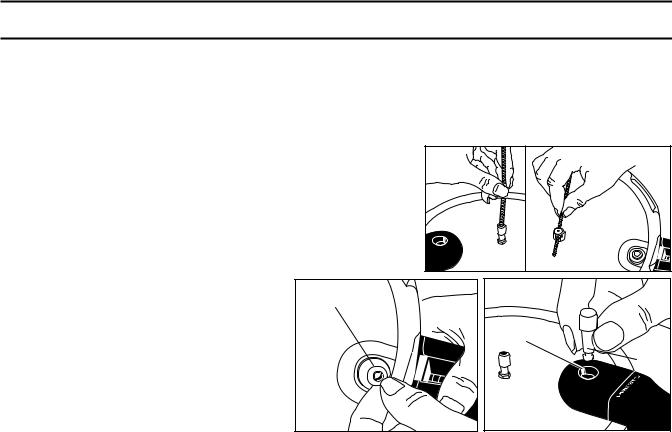
in bodily injury or property damage. Always be sure the cover handle is directly above the body handle (see page 4, Fig. E). Do not turn past handle alignment.
5.Never open the cooker when it contains pressure.. — The air vent /cover lock provides a visual indication of pressure inside the cooker. When it is up, there is pressure. When it is down, there is no pressure in the cooker and it can be opened. If the pressure cooker is opened before all of the pressure is released, the contents of the cooker will erupt and could cause bodily injury or property damage.
6.Replace the overpressure plug if it is hard, deformed, cracked, worn or pitted, or when replacing the sealing ring.. Replace the sealing ring if it becomes hard, deformed, cracked, worn, pitted, or soft and sticky.. — The overpressure plug is a secondary pressure relief valve which is designed to relieve excess pressure by releasing from the cooker cover in the event that the vent pipe becomes blocked. The overpressure plug is made of rubber, and when new, is soft and pliable. Over time, depending on the frequency and type of use, rubber becomes hard and inflexible. When hard and inflexible, the overpressure plug loses its ability to act as a secondary pressure relief valve. It should be replaced immediately.
Should the overpressure plug ever be forced out of the cover due to excess pressure while cooking, it is important to call the Test Kitchen at 1-800-368-2194. Do not attempt to use the released overpressure plug.
7.Always follow special procedures found in the instruction book when pressure cooking rice, grains, and dry beans and peas.. — During cooking, dry beans and peas tend to froth and foam which could cause the vent pipe to become blocked. Therefore, dry beans and peas need to be soaked and cooked according to instructions beginning on page 29. Using this method will keep foam at safe levels during cooking. Like dry beans and peas, rice and grains tend to froth and foam during cooking; therefore, to contain foaming and frothing during the cooking period, rice and grains must be prepared in a bowl in the pressure cooker according to directions on page 31.
8.Never pressure cook applesauce, cranberries, rhubarb, cereals, pastas, dried soup mixes, or dry beans and peas which are not listed in the chart on page 29.. — These foods expand so much as a result of foaming and frothing that they should never be cooked under pressure.
Care and Maintenance
1.All parts of your pressure cooker, including the sealing ring and pressure regulator, are fully immersible for easy cleaning. When washing the unit, however, the sealing ring should always be removed to allow easy cleaning of the inside rim of the cover. The sealing ring should be washed with hot, sudsy water after each use.
2.To be sure the vent pipe is clear, hold the cover up to the light and look through the vent pipe. Clean it with a small brush or pipe cleaner if it is blocked or partially blocked (Fig. K). Also clean the vent pipe nut as shown.
Fig.. K
Cover Handle
Hole
Metal
Shaft
Fig.. M
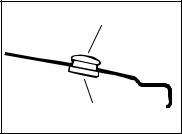
4. The overpressure plug can also be removed for cleaning by pushing it out of its opening from the top of the cover. After cleaning, reinsert it by pushing the domed side of the plug into the opening from the underside of the cover, until the bottom edge is fully and evenly seated against the underside of the cover (Fig. N). When the overpressure plug is properly installed, the word (TOP) will be visible on the
overpressure plug when viewing the outside of the cover.
5.Iron and other minerals in water and foods may darken the inside of your aluminum cooker. This discoloration will not affect the food cooked in the unit.
These stains can be removed by using a solution of water and cream of tartar. Use a tablespoon of cream of tartar for each quart of water and pour enough
solution into the cooker to cover the discoloration (do not fill over 2⁄3 full). Close the cover securely, place the pressure regulator on the vent pipe, and heat until the pressure regulator rocks gently. Remove the cooker from the heat and allow
it to stand for two to three hours. Remove the pressure regulator and discard the contents. Scour thoroughly with a soap impregnated steel wool pad; wash, rinse, and dry.
The outside surface of aluminum pressure cookers may be cleaned with a good silver polish if necessary. Staining may result if the cooker is washed in the dishwasher. If food residue adheres to the pressure cooker body, clean with a vegetable brush, a fine steel wool pad, or a fine kitchen cleanser.
6.When not in use, store your pressure cooker in a dry place with the cover inverted on the body. If the cover is locked on, unpleasant odors may form inside the unit and the sealing ring could be damaged.
7.As is the case of all cookware, avoid chopping or cutting food inside the cooker with a knife or other sharp utensil.
8.If the body or cover handles become loose, tighten them with a screwdriver.
9.Do not strike the rim of the pressure cooker with any cooking utensil because this could cause nicks in the rim which may allow steam to escape and prevent the pressure cooker from sealing.
10.The sealing ring, overpressure plug, and rubber gasket of the air vent/cover lock may shrink, become hard, deformed, cracked, worn, or pitted with normal use. Exposure to high heat, such as a warm burner or oven top, will cause these parts to deteriorate rapidly. When this happens, replace the sealing ring, overpressure plug, and small rubber gasket of the air vent/cover lock. Replace the sealing ring and overpressure plug at least every two years.
Leakage between the cover and body is usually caused by shrinkage of the sealing ring after prolonged use. Replace the sealing ring. Whenever you replace the sealing ring, replace the overpressure plug also.
11.Each time you clean or use your pressure cooker, check to be sure the bottom has not been damaged. Nicks and scratches may leave sharp edges that can damage ceramic stovetops or other smooth surfaces. Lift pressure cooker to remove it from burner. Sliding cookware could leave scratches on stovetops.
12.The formation of a small amount of moisture under the pressure regulator is normal when cooking first begins. It is the result of the temperature of the regulator being lower than the rest of the unit.
A small amount of steam or moisture may also be visible around the overpressure plug and air vent/cover lock as cooking begins. It should stop when pressure begins to build and the overpressure plug and air vent/cover lock seal. If leakage continues, clean or replace the overpressure plug and/or air vent/cover lock assembly. The pressure cooker will not seal if the gasket for the air vent/cover lock is cracked.
Do not operate your pressure cooker with continual leakage.. If the preceding steps do not correct the problem, return the entire unit to the Presto Factory Service Department (see page 37).
13.If for any reason the pressure cooker cannot be opened, contact the Consumer Service Department in Eau Claire, WI at 1-800-877-0441.
Any maintenance required for this product, other than normal household care and cleaning, should be performed by the Presto Factory Service Department (see page 37).
7

Helpful Hints
Your favorite recipes may be adjusted for cooking in the pressure cooker by following the general directions in this book for the particular type of food being cooked. Decrease the cooking time for your recipe by 2⁄3 since pressure cooking is much faster than ordinary cooking methods. For example, if your ordinary cooking method requires 45 minutes, in the pressure cooker the cooking time will be 15 minutes. Because there is very little evaporation, the amount of liquid used should be decreased. Use about 1⁄2 cup more liquid than you’ll desire in your finished dish. But, remember, there must always be water or some other liquid in the pressure cooker to produce the necessary steam.
Use the cooking rack when it is desirable to cook foods out of the cooking liquid. When foods are pressure cooked out of the liquid, flavors will not intermingle. Therefore, it is possible to cook several foods at once, as long as they have similar cooking times. If it is desirable to blend flavors, do not use the cooking rack.
Many different cooking liquids can be used in a pressure cooker. Wine, beer, bouillon, fruit juices, and of course water all make excellent cooking liquids in the pressure cooker.
Beautiful desserts and side dishes can be prepared in the pressure cooker, using individual or small metal molds or glass custard cups, which are ovenproof. Fill molds 2⁄3 full to allow for expansion of food, and fit them loosely into the pressure cooker on the cooking rack. Do not fill the pressure cooker over 2⁄3 full.
If a recipe says to cook 0 minutes, cook food only until the pressure regulator begins to rock. Then cool pressure cooker according to recipe.
The pressure cooker is usually cooled at once for delicate foods such as custards and fresh vegetables. For other foods, like meats, soups, and grains, let the pressure drop of its own accord.
When pressure cooking at high altitudes, the cooking time needs to be increased 5% for every 1000 feet above the first 2000 feet. Following this rule, the times should be increased as follows:
3000 ft. ... |
5% |
5000 ft. ... |
15% |
7000 ft. ... |
25% |
4000 ft. ... |
10% |
6000 ft. ... |
20% |
8000 ft. ... |
30% |
Because pressure cooking times are increased at altitudes above 2000 feet, an additional 1⁄2 cup cooking liquid will be needed.
If you have any questions on recipes, time charts, or the operation of your pressure cooker, call or write: Test Kitchen, National Presto Industries, Inc., 3925 North Hastings Way, Eau Claire, Wisconsin 54703-3703, phone 1-800-368-2194. You may also contact us at a our website www.GoPresto.com. When writing, please include a phone number and a time when you can be reached during weekdays, if possible. Written inquiries will be answered promptly by letter or telephone.
8
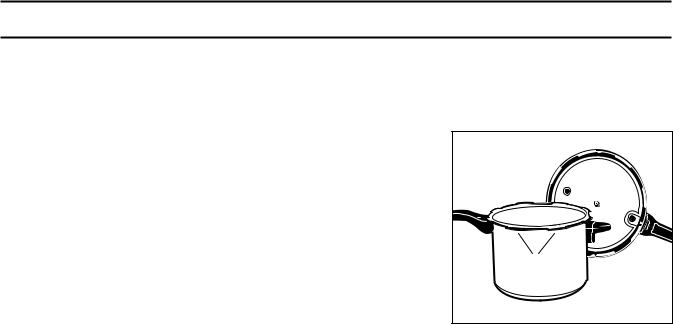
Questions & Answers
Occasionally the cover is hard to open or close. What causes this? What should I do?
In order for pressure to build inside your pressure cooker, the unit has a special cover which provides an airtight fit. Because of this, you may find that on occasion the cover may be difficult to open or close. The following suggestions will help if this happens:
If the cover seems hard to close, press the palm of your hand on the cover area directly opposite the cover handle while moving the cover handle to the closed position with your other hand.
If, after browning meat or poultry, the cover is difficult to close, it may be due to expansion of the pressure cooker body from heating. Remove the cover and allow the pressure cooker body to cool slightly and try again. Do not place the pressure cooker back on the burner until it is fully closed.
If necessary, to help make the cover easier to open and close, a very light coating of cooking oil may be applied to the sealing ring and to the underside of the lugs on the pressure cooker body (Fig. O). Use a pastry brush, a piece of cloth, or your fingertips and be sure to wipe off any excess oil.
Apply Cooking
Oil Here 
Apply
Cooking
Oil Here
Fig.. O
What can be done if the food prepared in the pressure cooker has more liquid than desired?
Simmer to evaporate the excess liquid. Next time you prepare the same recipe, you may want to use less liquid.
How does one prevent overcooking?
Remember to begin timing as soon as the pressure regulator begins to rock gently. It is very important to accurately time the cooking period. A Presto kitchen timer is very helpful for this purpose. Also be sure to follow the recipe instructions for cooling the pressure cooker.
What if the food is not completely done after the recommended cooking time?
Simply bring the cooker back up to pressure and cook the food a minute or two longer.
Can I use my stainless steel pressure cooker on all types of ranges?
Your pressure cooker will work on gas, electric coil and ceramic glass (smoothtop) ranges. In addition, stainless steel pressure cookers will work on induction ranges.
When cooking first begins, is it normal for steam to escape and moisture to form on the cover and between the handles?
It is normal for steam to escape and a slight amount of moisture leakage to form on the cover and between the handles when cooking first begins. If leakage continues, the cover handle may not be properly aligned with the body handle and, therefore, the cover lock cannot engage.
Is it normal for the air vent/cover lock to rise up partially and drop back down when cooking first begins?
It is possible that the air vent/cover lock will move up and down slightly when cooking first begins. Do not be concerned. The air vent/cover lock will remain in the up position once the cooker has sealed. However, if the air vent/cover lock continues to move up and down or rises partially, tap it lightly with the tip of a knife. If it does not rise once you have tapped it, the following may be occurring:
1.The burner is not hot enough.
2.The cooker is not fully closed (see page 4).
3.There is insufficient liquid to form steam.
4.The gasket for the air vent/cover lock needs to be replaced (see page 6).
9

Soups and Stocks
The pressure cooker is perfect for preparing delicious, nourishing soups and stocks in minutes instead of the hours taken by ordinary methods.
Stocks form the base for most great soups and sauces, and you can even substitute a stock for water in many recipes to add extra flavor. Traditionally, stocks are made by simmering bones and scraps for hours to extract all their flavor. With the pressure cooker, you can do the same thing in just minutes by following the simple directions on the following pages.
We’ve also included a few favorite soup recipes and, if you have a favorite recipe of your own, try it in the pressure cooker using one of the recipes in this book as your guide. If adding dry beans and peas, they must first be soaked according to directions on page 29. Do not pressure cook soups containing barley, rice, pasta, grains, dry beans and peas which are not listed in the chart on page 29, and dried soup mixes because they have a tendency to foam, froth, and sputter and could block the vent pipe.
Cooked barley, rice, grains, pasta, dry beans and peas which are not listed in the chart on page 29, and dried soup mixes should be added to the soup after pressure cooking.
FOR SOUPS AND STOCKS,
DO NOT FILL PRESSURE COOKER OVER 1⁄2 FULL!
Operating the cooker without cooking liquid oR allowing the cooker to boil dry will damage the cooker.
CHICKEN SOUP
11⁄2 |
pounds chicken, cut into serving |
1⁄2 |
cup chopped onion |
|
pieces |
1⁄4 |
cup chopped celery |
4 |
cups water |
|
1 teaspoon salt |
1⁄2 |
cup sliced carrots |
1⁄4 |
teaspoon black pepper |
Place all ingredients in cooker. Close cover securely. Place pressure regulator on vent pipe and cook 12 minutes with pressure regulator rocking slowly. Let pressure drop of its own accord.. Remove pieces of chicken from cooker and let cool. Remove meat from bones and return meat to cooker. Heat through.
Nutrition Information Per Serving |
4 servings |
160 Calories, 8 g Fat, 54 mg Cholesterol |
|
Delicious Soups From Chicken Soup...
CHICKEN SOUP STOCK — Strain Chicken Soup to make stock.
CHICKEN NOODLE SOUP — Bring soup to a boil. Add fine noodles and simmer, uncovered, 10 to 15 minutes. Salt and pepper to taste.
6 servings
CHICKEN DUMPLING SOUP — Mix together 1 beaten egg, 1⁄2 cup milk, and 1⁄2 teaspoon salt. Stir in 11⁄8 cups flour. Drop mixture from teaspoon into bubbling Chicken Soup in cooker. Simmer dumplings uncovered 6 minutes.
6 servings
CHICKEN RICE SOUP — Add 1 cup cooked rice to Chicken Soup. Heat through. Salt and pepper to taste.
6 servings
10
BROWN BEEF SOUP
11⁄2 |
pounds lean beef, cut into 1-inch |
1⁄4 |
cup chopped celery |
|
cubes |
1 |
bay leaf |
4 |
cups water |
1 |
teaspoon parsley flakes |
1⁄2 |
cup chopped onion |
1 |
teaspoon salt |
1⁄2 |
cup sliced carrots |
1⁄4 |
teaspoon black pepper |
Place all ingredients in cooker. Close cover securely. Place pressure regulator on vent pipe and cook 12 minutes with pressure regulator rocking slowly. Let pressure drop of its own accord..
Nutrition Information Per Serving |
4 servings |
295 Calories, 15 g Fat, 110 mg Cholesterol |
|
Delicious Soups From Brown Beef Soup...
BROWN BEEF SOUP STOCK — Strain Brown Beef Soup to make stock.
ONION SOUP — Pour 2 tablespoons vegetable oil into cooker and sauté 11⁄2 cups thinly sliced onions. Stir onions into 6 cups Brown Beef Soup Stock in cooker. Season with 1⁄4 teaspoon pepper. Close cover securely. Place pressure regulator on vent pipe and cook 2 minutes with pressure regulator rocking slowly. Let pressure drop of its own accord..
Ladle into soup bowls. Top with Parmesan cheese. If desired, garnish with croutons or toasted French bread.
6 servings
BEEF TOMATO SOUP — Add 2 cups tomato juice and 1 cup cooked rice to Brown Beef Soup. Heat through.
|
|
|
8 servings |
|
Black Bean Soup |
||
2 |
cups dry black beans |
4 |
cups chicken stock or broth |
1 |
tablespoon olive or vegetable oil |
2 |
cups sliced carrots, 3⁄4-inch thick |
1 |
cup chopped onion |
1 |
tablespoon packed brown sugar |
3 |
cloves garlic, minced |
2 |
teaspoons white wine vinegar |
1-2 |
jalapeño chiles, seeded, deveined, |
|
• • • • • • • |
|
minced |
1 |
cup loosely packed fresh cilantro, |
1 |
tablespoon chili powder |
|
chopped |
11⁄2 |
teaspoons oregano |
|
Salt to taste |
1⁄2 |
teaspoon allspice |
|
|
Soak beans according to instructions on page 29. Pour oil in pressure cooker. Sauté onion, garlic, chiles, chili powder, oregano, and allspice for 2 minutes. Stir in beans, chicken stock, carrots, brown sugar, and vinegar. Close cover securely. Place pressure regulator on vent pipe and cook 12 minutes with pressure regulator rocking slowly. Let pressure drop of its own accord.. Remove 1 cup of bean mixture, place in blender and purée until smooth. Return to pressure cooker and stir in fresh cilantro.
Nutrition Information Per Serving |
8 servings |
231 Calories, 3 g Fat, 0 mg Cholesterol |
|
11
SAFFRON FISH STEW
1 |
can (141⁄2 ounces) chicken broth |
|
Pinch of saffron threads |
1⁄4 cup dry white wine |
|
or 1⁄4 teaspoon turmeric |
|
4 |
new red potatoes, quartered |
|
• • • • • • • |
3 |
carrots, cut into 1⁄2-inch chunks |
1 |
pound firm fish (halibut, haddock, |
1 |
medium onion, finely chopped |
|
cod, pollack) fresh or thawed, cut |
2 |
cloves garlic, minced |
|
into 8 pieces |
1⁄4 |
cup chopped parsley |
1 |
small red pepper, cut into chunks |
1 |
bay leaf |
1 |
cup frozen peas, thawed |
Place broth, wine, potatoes, carrots, onion, garlic, parsley, bay leaf, and saffron in pressure cooker. Close cover securely. Place pressure regulator on vent pipe and cook 2 minutes with pressure regulator rocking slowly. Cool cooker at once.. Add fish, pepper, and peas. Close cover securely. Place pressure regulator on vent pipe and cook 1 minute with pressure regulator rocking slowly. Cool cooker at once.. Discard bay leaf.
Nutrition Information Per Serving 8 servings 174 Calories, 1 g Fat, 40 mg Cholesterol
MINESTRONE
1 |
pound lean beef, cut into 1-inch |
11⁄2 |
teaspoons basil |
|
cubes |
1 |
teaspoon salt |
5 |
cups water |
1 |
bay leaf |
1 |
can (14-15 ounces) diced |
1⁄4 |
teaspoon black pepper |
|
tomatoes |
|
• • • • • • • |
1⁄2 |
cup chopped onion |
1 |
can (16 ounces) Great Northern |
1 |
cup sliced carrots |
|
beans |
1⁄4 |
cup chopped celery |
1 |
can (15 ounces) cut green beans, |
1 |
clove garlic, minced |
|
drained |
2 |
tablespoons parsley flakes |
2 |
ounces fine noodles |
Place beef, water, tomatoes, onions, carrots, celery, garlic, parsley, basil, salt, bay leaf, and pepper in cooker. Close cover securely. Place pressure regulator on vent pipe and cook 10 minutes with pressure regulator rocking slowly.. Let pressure drop of its own accord..
Add Great Northern beans, green beans, and noodles. Simmer uncovered 10 minutes. Garnish with Parmesan cheese, if desired.
Nutrition Information Per Serving |
10 servings |
234 Calories, 6 g Fat, 44 mg Cholesterol |
|
POTATO SOUP
1 |
tablespoon vegetable oil |
1⁄4 |
teaspoon basil |
1 |
cup finely chopped onions |
|
• • • • • • • |
1⁄2 |
cup finely sliced celery |
1 |
can (12 ounces) evaporated skim |
3 |
cups chicken broth |
|
milk |
4 |
cups peeled, diced potatoes |
|
Salt to taste |
1⁄4 |
teaspoon white pepper |
|
|
Heat oil in pressure cooker over medium heat. Sauté onion and celery until soft. Add broth, potatoes, pepper, and basil to pressure cooker. Close cover securely. Place pressure regulator on vent pipe and cook 5 minutes with pressure regulator rocking slowly. Let pressure drop of its own accord.. Remove 2 cups of potato mixture; place in blender or food processor and process until smooth. Return to pressure cooker and stir in evaporated milk.
Nutrition Information Per Serving |
6 servings |
160 Calories, 2 g Fat, 2 mg Cholesterol |
|
12
